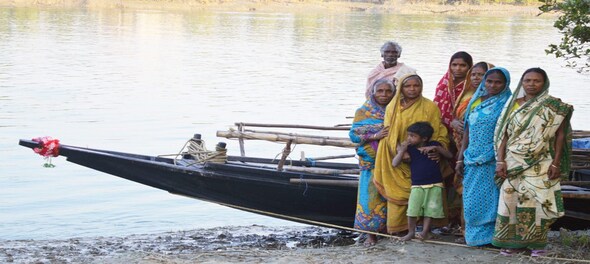
The day her husband’s fishing party was heading out to sea, Madhobi Majhi* had arranged for a prayer ceremony for Bonobibi (the resident goddess of the forest) in their house, as was the custom. Soon before the ritual was to start, however, a stray dog came in and excreted over the foundation on which the holy idol was to be enshrined. “It was a warning from the Goddess,” Madhobi rues. But the pangs of poverty and hunger pushed the men to set out and earn their daily bread regardless. They wound up in the claws of the tigers of the Sundarbans.
Madhobi was 21 then. Days after her husband’s death, she found out that she was pregnant with their second child. Now 45, the Dulki resident recalls, “The tiger took away my husband, my livelihood. I don’t want my sons to go back there. If they are gone, what will I have left?” That’s why she forced them into the tourism industry. “I did it against the rules of my community, which decrees that every son should follow in the footsteps of the father.”
Madhobi is not against the tigers that killed her husband. “It is because of the tiger that the forest survives and, because the forest survives, we have food and tourists,” she says pragmatically. Unable to find a job as an agricultural labourer, she has been financially dependent on her brother-in-law all these years. “We are puppets at the hands of the Devi.”
Sundarbans is the only mangrove tiger land of the world, a UNESCO world heritage site spread over 140,000 hectares spanning India and Bangladesh. More than 100 tigers roam free here, according to a 2014 study.
The massive crisis looming in the region is the man-animal conflict: the 2011 Census estimated that about 4.3 million people coexist with the endangered Royal Bengal tiger in the Sundarbans.
According to authorities, 10 tiger attacks take place every year, but villagers claim that at least 10 people die of tiger attacks every month, the count reaching 30 in times of cyclones and floods when the land-water divide becomes soluble and the forest and human settlements converge.
A majority of the population depends on the forest resources for their livelihood: wood cutting, honey collection, fruit collection, wax collection, crab collection, breeding prawns, and fishing. The salinity of the soil is unfavourable for agriculture, even though working on land is the most sought-after option so as to avoid going into the forest.
Tiger widows don’t just face a precarious future in terms of livelihood; they also face active daily discrimination. Called bagh bidhoba by the locals, they are targeted with the slur of ‘husband-eaters’ (swami khejo) as they are considered responsible for the death of their spouse by animal attack. They are also burdened with numerous ritualistic practices to keep Bonbibi satisfied.
Madhobi’s nephew Krishna Majhi*, a worker at the local hotel states, “Had she given birth to a girl the second time, there would have been pressure on us
These widows are compelled to accept cultural and social injustice through the propagation of Sundarbans’ folk epic Bonbibi’r Johuranama (‘The Life and Miracles of Bonbibi’, which is adhered to by both Hindus and Muslims). It is believed that the goddess punishes those who are evil and exploitative in nature, eyeing to gain profits from the forest rather than simply garnering the required amount for their survival, by never coming to their rescue.
Epochs ago, the local belief had lead to the creation of tiger widow villages (bidhoba pally): widows were thrown out of their homes and forced to live in ostaricised hamlets at the periphery of the forest resident areas, reminding us of the spatial politics in Vrindavan and its similar housing of upper-caste widows. With time, the population of Sundarbans has increased, resulting in higher human-tiger conflict. Now, the widows are no more thrown out of the house as there are hardly any men left in villages owing to the increased number of deaths caused by tiger attacks.
The tiger widow undergoes post-trauma psychological scars at various levels: from deprivation, abuse and exploitation. According to a study published by the Indian Journal of Psychiatry, tiger widows report higher levels of fear, negative feelings, discrimination, community attitudes and spiritual dimensions compared with both normal and snake-bite widows.
During my research, while talking to 60 tiger widows in Sundarbans, I realized that they speak in metaphors – often referring to the boat of occupation, the house of the fishes, or occupational partner. Once, I asked a group of these women to pose for me by standing on a boat anchored by the banks of the village.

They vehemently refused, stating that they have been barred from accessing the boat as it is a means of livelihood. It is particularly devastating as many of these women were once skilled in fishing and were the occupational partner of their husbands. Now, their husbands and livelihoods are both gone.
The West Bengal Government’s Bidhoba Bhata (widow pensions) scheme is still to extend its reach in the innermost pockets of Sundarbans where, in any case, compensations for the death by tiger attacks are rare. Environmentalists defending the Sundarbans tend to keep the plight of the humans of the area away from the consciousness of the general public, but we need to look at the subject from both points of view while moving forward.
*First name changed, keeping surname intact for indicating the occupation, caste and religious dimensions
Amrita Dasgupta is an M.Phil research scholar at Jadavpur University
First Published: Sept 8, 2018 12:01 AM IST
Check out our in-depth Market Coverage, Business News & get real-time Stock Market Updates on CNBC-TV18. Also, Watch our channels CNBC-TV18, CNBC Awaaz and CNBC Bajar Live on-the-go!



